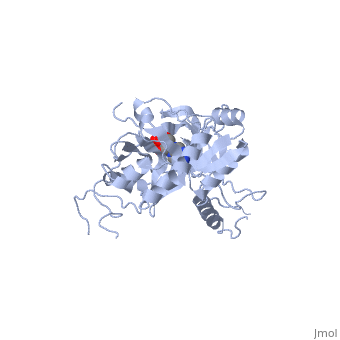ATP-dependent DNA ligase from bacteriophage T7
From Proteopedia
(Difference between revisions)
| Line 17: | Line 17: | ||
Catalytic function with DNA | Catalytic function with DNA | ||
| - | ATP-dependent DNA ligase from bacteriophage T7 amends a fractured DNA strand through esterification of a 5'- phosphoryl to a 3'- hydroxyl group. This mechanism occurs with the aid of ATP in several steps. First, the ligase is activated through a phosphoramidate bond with a lysine residue in the active site (Lys 34). A pyrophosphate leaves and the enzyme-AMP complex is formed. Next, the AMP is transferred to the 5' phosphate group at the nick in the DNA. Finally, T7 ligase creates the phosphodiester bond between the 5' -phosphoryl and the 3' – hydroxyl group, with AMP being freed. All ATP-dependent DNA ligases contain a conserved amino acid sequence of KxDGxR. This includes the lysine residue which binds the ATP in the groove between the two domains. | + | ATP-dependent DNA ligase from bacteriophage T7 amends a fractured DNA strand through esterification of a 5'- phosphoryl to a 3'- hydroxyl group. This mechanism occurs with the aid of ATP in several steps. First, the ligase is activated through a <scene name='56/567310/Amp_complex/1'>phosphoramidate bond with a lysine residue</scene> in the active site (Lys 34). A pyrophosphate leaves and the enzyme-AMP complex is formed. Next, the AMP is transferred to the 5' phosphate group at the nick in the DNA. Finally, T7 ligase creates the phosphodiester bond between the 5' -phosphoryl and the 3' – hydroxyl group, with AMP being freed. All ATP-dependent DNA ligases contain a conserved amino acid sequence of KxDGxR. This includes the lysine residue which binds the ATP in the groove between the two domains. |
</StructureSection> | </StructureSection> | ||
Revision as of 19:01, 6 November 2013
ATP-DEPENDENT DNA LIGASE FROM BACTERIOPHAGE T7
| |||||||||||
Proteopedia Page Contributors and Editors (what is this?)
William Guthrie, Hunter Douglas, Jeremy A. Hammett, Jaime Prilusky

